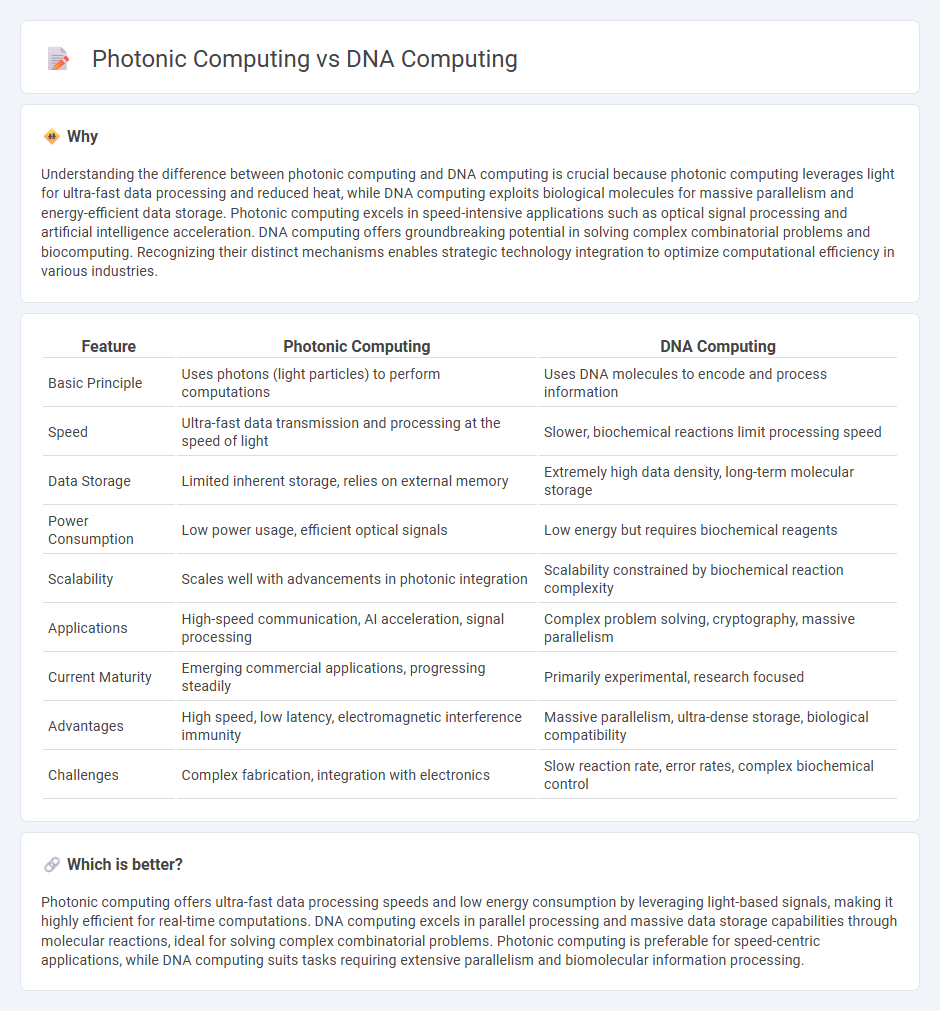
Photonic computing uses light particles to perform computations, offering unparalleled speed and energy efficiency compared to traditional electronic processors. DNA computing harnesses the natural molecular processes of deoxyribonucleic acid to solve complex problems through massive parallelism and data storage density. Explore deeper into how these cutting-edge technologies are revolutionizing computation and shaping the future of data processing.
Why it is important
Understanding the difference between photonic computing and DNA computing is crucial because photonic computing leverages light for ultra-fast data processing and reduced heat, while DNA computing exploits biological molecules for massive parallelism and energy-efficient data storage. Photonic computing excels in speed-intensive applications such as optical signal processing and artificial intelligence acceleration. DNA computing offers groundbreaking potential in solving complex combinatorial problems and biocomputing. Recognizing their distinct mechanisms enables strategic technology integration to optimize computational efficiency in various industries.
Comparison Table
| Feature | Photonic Computing | DNA Computing |
|---|---|---|
| Basic Principle | Uses photons (light particles) to perform computations | Uses DNA molecules to encode and process information |
| Speed | Ultra-fast data transmission and processing at the speed of light | Slower, biochemical reactions limit processing speed |
| Data Storage | Limited inherent storage, relies on external memory | Extremely high data density, long-term molecular storage |
| Power Consumption | Low power usage, efficient optical signals | Low energy but requires biochemical reagents |
| Scalability | Scales well with advancements in photonic integration | Scalability constrained by biochemical reaction complexity |
| Applications | High-speed communication, AI acceleration, signal processing | Complex problem solving, cryptography, massive parallelism |
| Current Maturity | Emerging commercial applications, progressing steadily | Primarily experimental, research focused |
| Advantages | High speed, low latency, electromagnetic interference immunity | Massive parallelism, ultra-dense storage, biological compatibility |
| Challenges | Complex fabrication, integration with electronics | Slow reaction rate, error rates, complex biochemical control |
Which is better?
Photonic computing offers ultra-fast data processing speeds and low energy consumption by leveraging light-based signals, making it highly efficient for real-time computations. DNA computing excels in parallel processing and massive data storage capabilities through molecular reactions, ideal for solving complex combinatorial problems. Photonic computing is preferable for speed-centric applications, while DNA computing suits tasks requiring extensive parallelism and biomolecular information processing.
Connection
Photonic computing and DNA computing both harness unconventional physical processes to perform computations beyond traditional electronic methods, utilizing light and biological molecules respectively to achieve high-speed and parallel data processing. Photonic computing uses photons to transmit and process information with minimal heat and maximum speed, while DNA computing exploits the massive parallelism and data density inherent in molecular biology to solve complex problems. Together, these emerging technologies represent a paradigm shift in computing by leveraging physical and biochemical properties for enhanced efficiency and scalability.
Key Terms
Biomolecular operations
DNA computing leverages biomolecular operations such as hybridization, ligation, and enzymatic reactions to perform complex computations at the molecular level, enabling massive parallelism and low energy consumption. Photonic computing uses light-based components including lasers, modulators, and nonlinear optical elements for ultrafast data processing and signal manipulation with minimal heat generation. Explore the latest advancements in biomolecular operations to understand their impact on next-generation computational technologies.
Optical signal processing
Optical signal processing in photonic computing leverages light's high-speed and parallel processing capabilities, enabling ultra-fast data transmission and low-latency operations critical for real-time applications. DNA computing, while powerful in massive parallelism for complex problem solving, lacks the intrinsic speed and efficiency in handling optical signals compared to photonic systems. Explore more about how photonic computing revolutionizes optical signal processing and its advantages over DNA computing.
Parallelism
DNA computing leverages massive parallelism by harnessing the natural ability of DNA molecules to simultaneously process and store vast amounts of information through biochemical reactions. Photonic computing exploits parallelism via light beams that can cross paths without interference, enabling concurrent data transmission and processing at the speed of light within optical circuits. Explore how these groundbreaking technologies transform computational parallelism by learning more about their unique mechanisms and applications.
Source and External Links
DNA computing - Wikipedia - DNA computing uses DNA, biochemistry, and molecular biology hardware to perform computations, with advances such as DNA-based neural networks and efforts to improve speed via localized computing techniques.
The DNA computer: super hard drive of the future? - DNA computing encodes information in the nucleotide bases A, T, C, and G, offering high-density, long-term data storage and the possibility of biological molecule production through cellular machinery, although developing an effective system architecture remains a key challenge.
For First Time, DNA Tech Offers Both Data Storage and Computing ... - A new DNA computer can store, retrieve, compute, erase, and rewrite data repeatedly, mimicking many traditional electronic device functions, achieved by combining DNA with nanofibers to preserve and manipulate stored information.
 dowidth.com
dowidth.com